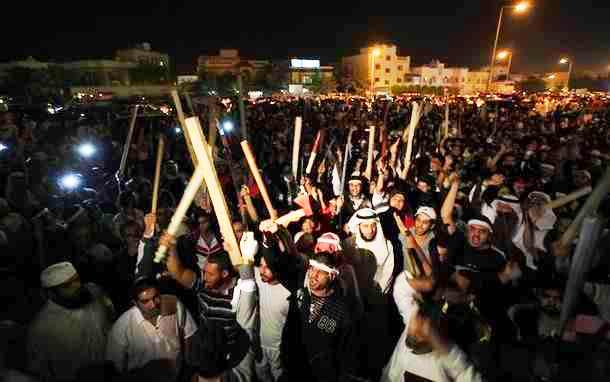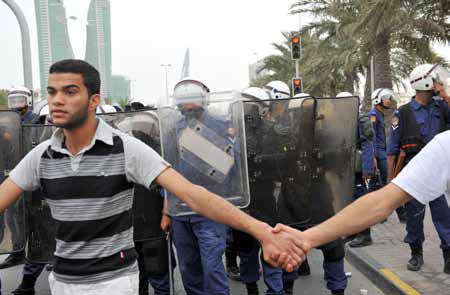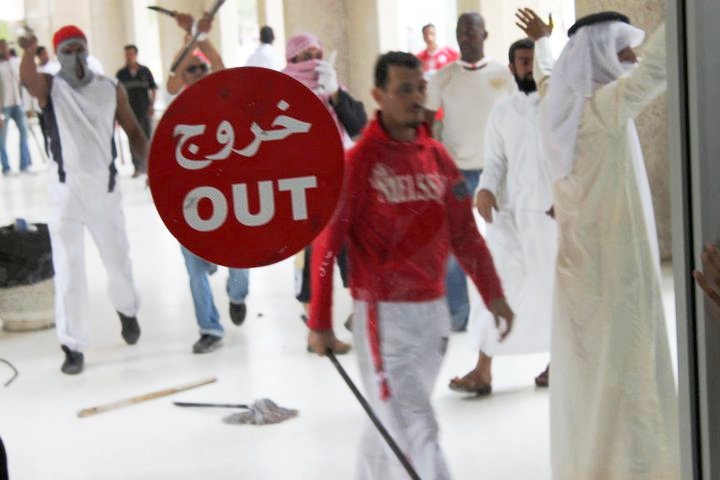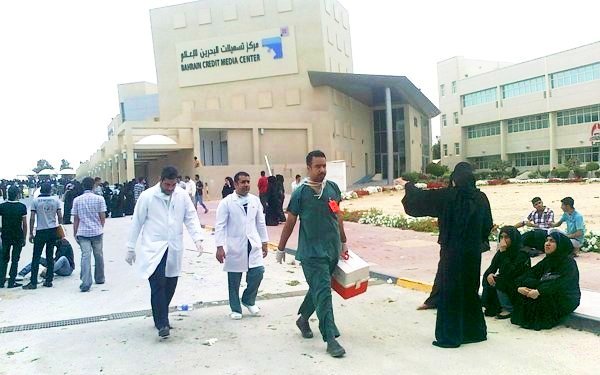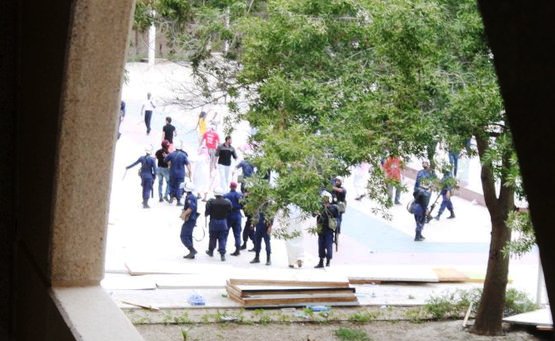Bahraini Doctors: A Thorn to the Regime - part5

2011-07-22 - 1:51 م
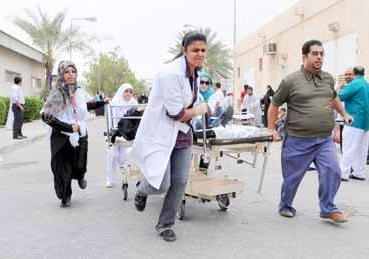 Bahraini doctors and nurses were not seen like that Bahrain Mirror (Exclusive): The doctors who have spent their days between medical books, hospital corridors, and their patients to the extent that alienated most of them from the public sphere of society, have suddenly found themselves at the center of that public sphere. They even became principal actors within it. A new awareness of society and the people have started to take form within the medical community during the crisis. They started to leave the enclosure of their profession to the openness of the public sphere, and abandon the isolation of the hospital walls and corridors to the streets crowding with people and homes that hid the wounded away from the eyes of the security forces. The doctors became more involved in the life of the community and what was going on in it; they became one of the many details of its daily stir. There was transformation in both the individual and collective awareness. Events not only make communities and states, but they also build new individuals and reconstruct the maps of their priorities and their relationships to the others. One doctor spoke of that new awareness: “The February 14th movement has transformed us from being an elite isolated from the community events to being so much attached to those events and people to the extent that we would hear people's whispers of pain as our own”. The doctors also spoke of the value that the 14th February events have added to their own existence, to their function in life, and to the human inside them. The doctors who were released recently, spoke very proudly and in high spirits about what they did, as similarly did the other medical staff. One of them said: “If those days returned I wouldn't hesitate to respond in the same way to my humanitarian obligations”. This event made us witness the medical staff in their white dress leave the hospital campus and run into the streets to treat the injured and be subjected to the threats of injury and even death themsleves. The fact that their own lives were at stake did not stop them, and it did not prevent some of them from storming into the most dangerous of places. In this part and the next one, we will see how the medical staff lived those moments when they were on the brink of death, and how they charged like warriors to where they faced death each moment, looking it in the eyes without looking for a retreat when they had to advance. Armed Horror The previous part (Part 4) ended with the events that took place in the evening of March 13th 2011, when armed Asian thugs, employed by the regime, attacked the Shia villages and Manama, and the ensuing events in Manama. What we could not cover in the previous part were the events that took place in the morning of that day. It was such an exhausting day for the medical staff from the morning until late at night. That morning, two events shook everyone: the attack on the protesters at the Financial Harbor and the troubes at the University of Bahrain. On that day, the Crown Prince declared his agreement to the principles of dialog, just three days before the attack on the roundabout that the Ministry of Interior named “Cleansing of the Roundabout”, followed by demolishing it completely. While the Crown Prince was calling for the immediate start of the dialog, armed gangs were speading chaos everywhere to thwart the dialog initiative(1) and to justify the repression by the security forces that was on its way, and which on the following day would enter Bahrain through the Suadi-Bahraini causeway. That approaching repression was the Peninsula Shield troops.
Al-Wefaq issued a statement condemning the spread of the armed gangs, stating that: There was no security anymore for the citizens after the rampage of the armed militias that attacked the citizens in their neighborhoods and their educational institutions, targeting them with sharp tools and cold weapons”. Al-Wefaq held “the government completely responsible for those armed gangs, their connections to the government were evident after the government relinquished its responsibility for preventing those armed groups. They closed a number of the roads and alleys and set up checkpoints in some areas. A Charge at the Financial Harbor.. On the other side, the February 14th youths whose movement was not attached to any political society have started, in return, a round of escalation. They had threatened earlier that if their planned march to the Royal Court in Riffa on March 11th was attacked by the security forces, then they would stage a sit-in at the Financial Harbor. Their march was attacked, and it was time for them to put their threat to action. The Financial Harbor which is about half a kilometer to the east of the Pearl Roundabout turned, during the events, into a new symbol after Al-Wefaq political society revealed in a press conference, a few days earlier, a document proving the selling of the Financial Harbor land to the Prime Minister for only one Bahraini Dinar.
The date set for the sit-in at the Financial Harbor was the morning of March 13th. But since the dawn of that day, news started to cicrulate over Twitter and Facebook that armed thugs had started to flock to the area to stir chaos and blame it on the protesters. Numerous youths left the roundabout to the Harbor. It was rumord that they drove out the armed thugs from the area, and closed the roads to the Financial Harbor and Seef district to prevent the return of those thugs. Another purpose for the blocking was to prevent the security forces from reaching there too. The blocking of the road caused a severe traffic jam in the early morning. The security forces moved to open the road(3). The events escalated and clashes took place between the two sides. Soon, the traffic came to a halt in all the areas. The security forces removed the tents the youth had erected earlier. Hundreds of injuries reached Salmaniya Hospital, ranging from suffocation by tear gas to rubber bullets(4). Filmed clips show tragic scenes. A video clip shows an unarmed citizen being shot at directly and for serveral times while he was standing a meter away from the police and was trying to talk to them(5). Tension paralyzed Bahrain completely. The ambulances could not handle the number of injuries, so private cars transported the wounded.
The security forces called upon the crowd at the harbor to go back to the roundabout. Youths calls over social media and cell phones called for mass presence at the roundabout to prevent the police from attacking it. The Harbour confrontations moved to the roundabout. The police forces deployed on the bridge overlooking the roundabout. The forces continued to fire tear gas on the roundabout. The youths climbed toward the bridge to block the road and prevent the police from attacking the roundabout, resulting in hundreds of suffocation cases by tear gas. They were treated at the roundabout by the medical staff who was available there. The number of injured exceeded the medical tent capacity. The doctors unrolled carpets outside the tent to treat the injured on the ground(6). The more difficult cases were transported to Salmaniya Hospital. A nurse recalled: "We were at the roundabout struggling with the tear gas while trying to treat the injured. We didn't know what would happen in the next moment". Another group of the medical staff waited behind the youths who climbed the bridge. The video scenes show how the protesters were attacked by tear gas and rubber bullets. In one video, a policeman is shown firing live bullets at the protesters. Charges and retreat maneuvers between the security forces and the protesters continued until 11:00 AM, when the security forces finally withdrew. A female doctor remebered: “We were standing behind the youths who climbed the bridge. We saw them with our own eyes rolling from the top of the bridge down to the ground. The ambulances were standing a little at the back. Those who fell were removed by a private pickup truck to the ambulance that will transport them to Salmaniya Hosptial”. Horror at the University The events at the Harbour spread tension all over Bahrain. Civil disobedience was declared, and many employees left their workplaces and drove toward the Roundabout. The University of Bahrain was not isolated from these events. A large number of students took out into angry demonstrations condemning what had happened. They marched among the university buildings. At 9:30 AM(7), minor confrontations took place between the protesting students and pro-government students. The confrontations were normal and limited, but an outsider turned the university into a real horror.
Scores of armed men with iron rods, sticks and wooden planks with nails fixed to them were allowed to enter the university through its main gate (8)+(9). The armed men headed to the protesting students. They attacked the students and beat them up, injuring many of them. The male students quickly lined up into a human chain to protect the female students. The armed men attacked the buildings and terrorized the students (10). The university security and administration did not intervene. Horror and screams spread out at the university campus. Distress calls reached the protesters at the roundabout over cell phones when the protesters had just regained control of the roundabout. A number of the youths at the roundaoubt rushed to the university. An ambulance equipped with medical staff left to the University as well. A female doctor recounted: ”We left in one ambulance only because we weren't sure of the news. We wanted to assess the situation before calling for more ambulances”. A female medical staff who was at the university between 12:00 and1:30 PM remebered: “We received the news about the university when we were at the roundabout treating the protesteres who were injured at the Financial Harbor and the roundabout. We were four doctors with a number of the medical aides. We weren't denied entry to the university, and there was another ambulance from the Bahrain International Hospital that arrived before us, but some of the ambulances that came later were not allowed to enter”. On one video clip a doctor says: "We weren't allowed to enter. I said to him (the security guard): I'm a doctor, can't you see my dress. He asked me if I was from Salmaniya Hospital or Militiary Hosptial, I replied him that there was no difference, all of us treated patients. He didn't allowed us to enter". The video also shows some of the cases that were admitted to Salmaniya Hospital and the anger that prevailed over the medical staff for what had happened at the universtiy on that day(11). The female docter who came with the first amulance continued her story to Bahrain Mirror: “When we entered we saw a group of men, some of them couldn't be at university age. They had cold weapons, wooden planks with nails, and strange-shaped swords. We went in one ambulance to make sure what we had heard was not a rumor. We were shocked by the frightening scene we saw: scores of armed men, most of them wearing balaclavas, and a large number of them wearing the traditional Arab dress were standing with the anti-riot police ”. She continued: “The medical staff got off carrying the first aids kit and spread out in the university to look for the injured. Most of the cases that I treated were nervous breakdowns, and some sharp tool injuries”. Another doctor treated a protesting student with a large wound in his hand. The doctor performed his first aids and hauled the injured student on a minubus to Salmaniya Hospital at around 2:30 PM. The doctors treated the students from both sides and took them in the ambulance to Salmaniya Hospital. The female doctor continued to tell her story: “At the English Language building more than one medical staff group met. One of the senior doctors stressed that we were there to treat the injured from both sides. It didn't matter whether they were attackers or attacked. The clashes were still raging between the protesting students on one side and the opposing students and the armed men on the other, as well as the young men who had come from the roundabout to support the protesting students. This time, both sides took part in the violence. The security forces didn't intervene to stop the clashes. We treated some cases of incised wounds”. Police Protects the Armed Men.. After half hour of the clashes, the anti-riot police came and fired tear gas on the protesting students. The armed men stood beside the police. “We were surprised with what we witnessed, but we stood aside to be away from the clashes. Two of the university security guards were accompanying us: one was Shia and the other was Sunni. An armed man who was wearing shorts and too old to be a student attacked a doctor who was with us, and threatened him: you treat them, huh. An anti-riot policeman went to the attacker and restrained him, but soon he let go of him. The attacker immediately jumped on a female nurse who had a camera and was filming and pulled her clothes from the back, threw her to the ground and repeated the same threats to her. We were wearing our white uniforms and holding only our stethoscopes”, the doctor continued: “Another armed man wearing the traditional Arab dress came to us and attacked one of the female doctors while the security forces were watching and doing nothing”. This last incident was filmed and put on YouTube, but with a distorted caption claiming that the medical staff were attacked by 'Shia' protestors(12).
The ambulance was waiting, and inside it were some of the injured. The security forces threw a stun bomb on the ambulance. The ambulance glass broke and splinters hit an eye of one of the nurses, and a doctor's neck. The ambulance fled with all those in it. Nine of the medical staff remained behind without an ambulance, including our female doctor. “We were in panic. The armed men were surrounding us and we didn't know what they would do to us. Our lives were threatened. We were unarmed. Immediately we ran away with the armed men were chasing us. One of the university security guards was in front of us and the other was behind us. They opened a door of one building for us and locked it as soon as when ran inside. Soon the first attacker reached the building and broke the glass door. We asked the security guards: was there any other exit? He said: No. He took us inside one of the classrooms. He locked the door and switched off the lights. We were in real panic. We stayed for an hour there. The security guard said he would go out to explore the situation and come back. After fifteen minutes he took us out saying it was safe now”. The doctor continued: “They let us board a students' bus when the university was secured. While the bus was moving, we saw the police walking side by side with the armed men who had attacked us earlier. We were taken to the university administration building. We stayed there for about an hour and a half until the under-secretary of Health Ameen Assaati with the deputy chief of doctors Ali Ebrahim arrived and took us in an ambulance to Salmaniya Hospital”. After a long an exhausting day, the doctors started to talk with various media channels(13)، (14) about the details of the day. The Bahraini authorities' anger with the doctors expositions was rising, the mission to get rid of such voices was becoming more and more a pressing task for the regime. In the next part: : → What attrocities the medical staff were subjected to in Sitra events?
|
اقرأ أيضا
- 2024-07-10Bahraini Authorities Summon Head of Sanabis Ma'tam, Threaten "Actions" Due to Mourners' Chants Against Israeli Occupation
- 2024-07-10Political Prisoner Mohammad Al-Raml's Family Say He's Vomiting Blood Due to Poor Conditions, Fear for His Life
- 2024-07-09Ali Al-Majed Arrested After His Return to Bahrain
- 2024-07-08Yusuf Al-Muhafdha: Convicted Returnees to Bahrain Have the Right to a Lawyer, Retrial, and Legal Guarantees
- 2024-07-08Reciter Mahdi Sahwan: Head of Manama Police Informed Me of Ban on Reciters Traveling to Commemorate Ashura
